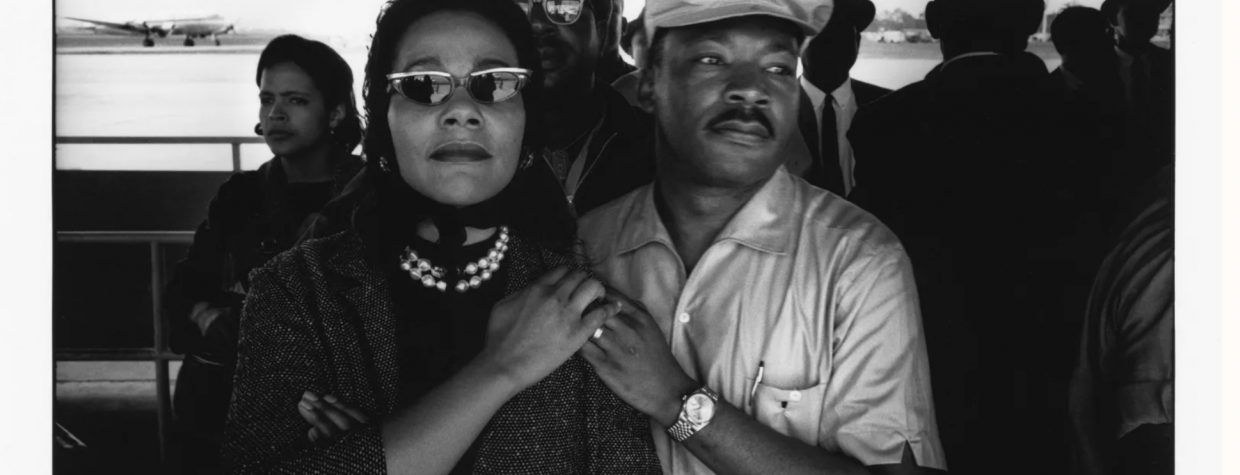Etherton Gallery is excited to announce the opening of its summer exhibition, Dan Budnik: Telling a Story Truthfully, which features a selection of photographs by renowned photojournalist, Dan Budnik (1933-2020), with mixed media works and photography by Caleb Gutierrez in the gallery pop-up, In the Cases. The exhibition runs from June 13 to September 16, 2023, with an opening reception on Saturday, June 17, 2023 at 7-10 pm. CMG will be in the courtyard spinning tunes.
“After Dan Budnik passed away in 2020, I wanted to celebrate his life with a show, and his family generously gave us complete access to his archive. As a result, Telling a Story Truthfully includes photographs that have never been seen until now. I am honored to share Dan’s work with Tucson. He documented some of the most important events in American history and made us feel like we were right there with him,” said Terry Etherton, Gallery Director and Owner of Etherton Gallery.
Like W. Eugene Smith, Danny Lyon, and Henri Cartier-Bresson, Dan Budnik worked outside the power structures of 20th century documentary photography, and became one of the great, independent, visual story tellers of his generation. Telling a Story Truthfully highlights Budnik’s powerful photographs of the Civil Rights Movement and the cultural figures who defined contemporary American art from the 1950s to the 1970s.
The foundation of Dan Budnik’s identity as a photographer is grounded in his experience as a young painting student studying at the Art Students League of New York. He studied with Charles Alston, the first African American artist to teach at the League, and listened to dinner conversations between Alston, boxer Joe Louis, and sociologist and civil rights activist, W.E.B. Du Bois, who co-founded the National Association for the Advancement of Colored People (NAACP). Alston also showed him Henri Cartier-Bresson’s book, The Decisive Moment, which inspired Budnik to become a photographer.
Budnik developed his skills making extended portraits of artists in their studios and less formal situations. In 1962, he spent two weeks with Abstract Expressionist artist, Willem de Kooning (1904-1997), until the artist almost forgot he was there, and made Willem de Kooning, 831 Broadway, NY, May, 1962. Through Budnik’s photograph we experience the profound sense of loss De Kooning felt at the death his friend and fellow artist, Franz Kline. In Diane Arbus, the Museum of Modern Art, New York, 1967, Budnik photographed his friend, Diane Arbus, at The Museum of Modern Art in a relaxed moment, camera equipment hanging around her neck, wearing a chic white minidress and matching thigh-high boots. Budnik also photographed Jasper Johns, Helen Frankenthaler, Louise Bourgeois, (among others), and frequently photographed Georgia O’Keeffe in her later years.
In 2014, actor and political activist, Harry Belafonte wrote that, “America does not often recount the stories of its people of color,” but Dan Budnik was dedicated to documenting the people and stories of the Civil Rights Movement, including Belafonte. He photographed Julie and Harry Belafonte with Charlton Heston leading a crowd to the Lincoln Memorial in March on Washington, Charlton Heston, Julie and Harry Belafonte leading the Hollywood and theatrical delegation to the Lincoln Memorial, Washington, D.C., 28 August 1963. In his now iconic portrait of Dr. Martin Luther King, Jr., March on Washington, Martin Luther King, Jr. after delivering his "I HAVE A DREAM" speech, Lincoln Memorial, Washington, D.C., 28 August 1963, we are standing right there at the side of the leader of the Civil Rights movement, and sense the impossible burden that King carried on his shoulders. Time Magazine used the image for the cover of the 50th Anniversary issue commemorating Dr. King’s speech.
Dan Budnik had been sleeping in his car, when he photographed a young “foot-soldier” who participated in the Selma to Montgomery March in 1965. He saw the young African American teenager, Will Henry “Do-Right” Rogers carrying an American flag as he walked along a dirt road to join other protesters, and made Selma to Montgomery, Will Henry ‘Do-Right’ looking back to left with homemade flag, 1965. In the image, Rogers looks behind him to the left with a palpable sense of apprehension. Cropped out of the image were eight soldiers who lined the road. Only one of them saluted the flag; the others turned their backs.
At the end of the Selma to Montgomery March, Budnik caught an intimate moment between husband and wife in Selma to Montgomery March, Coretta Scott King and Martin Luther King Jr., Montgomery Municipal Airport, Alabama, 24 March 1965. Dr. King looks off to his left, dressed like a civilian in his short sleeve shirt and cap, with his right hand resting on his wife’s shoulder. In contrast, Coretta Scott King looks directly at the camera, her face concealed behind her stylish sunglasses and scarf, but her feelings are revealed in a single, intimate gesture, as her hand covers her husband’s. Coretta King is quite literally her husband’s touchstone.
These are only some of the great photographs that will be on display this summer at Etherton Gallery in Dan Budnik: Telling a Story Truthfully. Through his photographs of the Civil Rights Movement and the cultural icons of mid-century America, Dan Budnik created an indelible historical record that remains as powerful in the age of George Floyd, as it was in the age of Dr. King.
For more information, visit ethertongallery.com.

